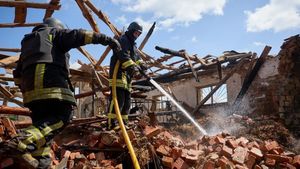Los Angeles is once again making headlines, this time for passing a significant "sanctuary city" ordinance aimed at protecting immigrants amid growing tensions surrounding federal immigration policies. On November 19, 2024, the Los Angeles City Council voted unanimously to adopt this new ordinance, which explicitly forbids the use of city resources for federal immigration enforcement.
Mayor Karen Bass, who is expected to sign the ordinance, emphasized its importance not just as legislation but as a message of reassurance to the city’s immigrant community, which is estimated to number around 4.4 million, with approximately half at risk of deportation. "This law is about making sure our immigrant community feels safe and protected here," Bass stated.
The ordinance builds on previous protections established by former Mayor Eric Garcetti, and it aligns closely with California's broader sanctuary laws. Notably, it prohibits the direct or indirect sharing of data with federal agencies such as Immigration and Customs Enforcement (ICE) and restricts officers from initiating contact based solely on immigration status.
Passage of the ordinance coincided with rising fears of mass deportations after Donald Trump’s recent election victory, wherein he vowed to ramp up immigration enforcement significantly. Councilmember Hugo Soto-Martinez, who pushed for the ordinance, asserted, "We’re sending a clear message: LA will not collaborate with ICE expired membership. We want people to have the faith to report crimes without the fear of deportation."">
At the council meeting, immigrant rights activists expressed their unwavering support for the ordinance, holding up signs with slogans like "Protect Our Neighbors" and "Make California a Sanctuary City". Their presence underscored the community's rallying sentiment as local lawmakers reiterated their commitment to safeguarding undocumented immigrants.
Despite this strong show of support, not everyone is convinced about the efficacy of such measures. Critics, including officials from the Los Angeles County Republican Party, have argued against the ordinance, stating it could potentially harbor criminals. They contend, "A country without secure borders isn't truly a country. This ordinance looks good on paper, but it does not stop federal authorities from doing their jobs. Those who’ve committed crimes shouldn’t be shielded from law enforcement."">
Indeed, the sanctuary city designation does not provide immunity from the federal law, and some experts believe it may even exacerbate the challenges for local law enforcement. Bill Essayli, California Assembly Republican leader, warned, "If cooperation is not established, ICE will operate more intensively within the community to locate and detain undocumented individuals, which could lead to increased tensions and safety issues for everyone involved."">
The past few years have seen Los Angeles already implement various protective measures, including Special Order 40, established by the LAPD back in 1979, which prevents officers from questioning individuals about their immigration status. The new ordinance, lauded as a significant step, nevertheless has drawn criticism over its potential symbolic nature, especially since previous versions of the law were already present.
Nevertheless, advocates for the ordinance argue it sends a strong message of solidarity with the city's diverse immigrant population. Council President Marqueece Harris-Dawson introduced amendments allowing for limited cooperation with federal agents but only for severe criminal offenses, echoing existing practices within local law enforcement.
"We are hardening our defenses against unjust federal actions," said Harris-Dawson at the council meeting. He stressed the importance of maintaining safety and trust within the community. By creating clear boundaries on cooperation with ICE, supporters hope the ordinance will empower immigrants to participate more fully in community and civic life without the looming threat of deportation.
While some worry about potential backlash from federal authorities, proponents believe such local policies will signal to other cities the importance of resisting encroachments on local governance and the safety of their residents. The ordinance signals broader trends across the nation as cities like New York and Chicago have similarly sought to fortify their sanctuary policies amid mass immigration enforcement threats.
Looking forward, Los Angeles officials acknowledge the challenges they will face during the implementation of this new ordinance. Logistics surrounding the training of agency staff for compliance is one obstacle, alongside the potential need for technological updates to secure data from federal agencies.
While many city officials and advocates are urging proactive public education campaigns to inform immigrant communities about their rights under the ordinance, current fears among residents persist due to the unpredictable nature of federal immigration policies. Jesus Carreon, representing the DACA community, encapsulated this sentiment during the meeting: "By passing this ordinance, we send the message to every immigrant in the city: you're not alone, you’re valued and worthy. This law reminds us all of the strength we share and our hopes for inclusion and safety."
It remains to be seen how lawful the practical implementation of this ordinance will be, and whether it can withstand the inevitable challenges posed by federal authorities. Still, the Los Angeles City Council's action symbolizes more than just policy; it reflects the city's commitment to promoting inclusivity and safety for every resident, regardless of their immigration status. With the new ordinance now poised to become city law, Los Angeles stands at the forefront of the national conversation surrounding immigration, local autonomy, and community safety—a topic’s urgency only expected to grow as federal immigration debates rapidly evolve.



